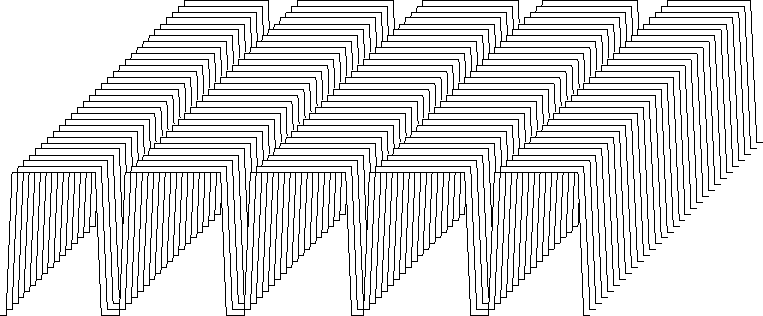The adjoint of extracting all the patches is adding them back.
Because of the overlaps, the adjoint is not the inverse.
In many applications, inverse patching is required;
i.e. patching things back together seamlessly.
This can be done with weighting functions.
You can have any weighting function you wish
and I will provide you
the patching reconstruction operator ![]() in
in
| |
(1) |
![[*]](http://sepwww.stanford.edu/latex2html/cross_ref_motif.gif) to add the weights of each window onto the wall
and finally to invert the sum wherever it is non-zero.
(You lose data wherever the sum is zero).
mkwallwtmake wall weight
to add the weights of each window onto the wall
and finally to invert the sum wherever it is non-zero.
(You lose data wherever the sum is zero).
mkwallwtmake wall weight
No matrices are needed to show that this method succeeds,
because data values are never mixed with one another.
An equation for any reconstructed data value ![]() as a function of the original value d and the weights wi
that hit d is
as a function of the original value d and the weights wi
that hit d is ![]() .Thus, our process is simply a ``partition of unity.''
.Thus, our process is simply a ``partition of unity.''
To demonstrate the program, I made a random weighting function to use in each window with positive random numbers. The general strategy allows us to use different weights in different windows. That flexibility adds clutter, however, so here we simply use the same weighting function in each window.
The operator
![]() is called ``idempotent.''
The word ``idempotent'' means ``self-power,'' because
for any N, 0N=0 and 1N=1,
thus the numbers 0 and 1 share the property that raised
to any power they remain themselves.
Likewise, the patching reconstruction operator
multiplies every data value by either one or zero.
Figure
is called ``idempotent.''
The word ``idempotent'' means ``self-power,'' because
for any N, 0N=0 and 1N=1,
thus the numbers 0 and 1 share the property that raised
to any power they remain themselves.
Likewise, the patching reconstruction operator
multiplies every data value by either one or zero.
Figure ![[*]](http://sepwww.stanford.edu/latex2html/cross_ref_motif.gif) shows the result
obtained when a plane of identical constant values
shows the result
obtained when a plane of identical constant values ![]() is passed into the patching reconstruction operator
is passed into the patching reconstruction operator ![]() .The result is constant on the 2-axis, which confirms
that
there is adequate sampling on the 2-axis,
and although the weighting function is made of random numbers,
all trace of random numbers has disappeared from the output.
On the 1-axis the output is constant,
except for being zero in gaps,
because the windows do not overlap on the 1-axis.
.The result is constant on the 2-axis, which confirms
that
there is adequate sampling on the 2-axis,
and although the weighting function is made of random numbers,
all trace of random numbers has disappeared from the output.
On the 1-axis the output is constant,
except for being zero in gaps,
because the windows do not overlap on the 1-axis.
|
idempatch90
Figure 3 A plane of identical values passed through the idempotent patching reconstruction operator. Results are shown for the same parameters as Figure ![[*]](http://sepwww.stanford.edu/latex2html/cross_ref_motif.gif) . .
|  |
Module patching assists in reusing the patching technique. It
takes a linear operator ![]() .as its argument and applies it in patches.
Mathematically, this is
.as its argument and applies it in patches.
Mathematically, this is
![]() .It is assumed that the input and output sizes for the operator
oper are equal.
patchinggeneric patching
.It is assumed that the input and output sizes for the operator
oper are equal.
patchinggeneric patching